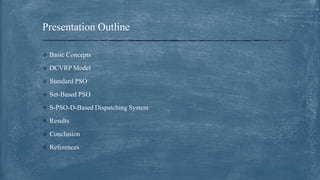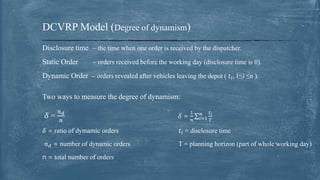A Dynamic Logistic Dispatching System With Set-Based Particle Swarm Optimization
- 2. November 24, 2019 Presented By: Name: Rajib Kumar Roy ID No: 1907561 A Dynamic Logistic Dispatching System With Set-Based Particle Swarm Optimization
- 3. Basic Concepts DCVRP Model Standard PSO Set-Based PSO S-PSO-D-Based Dispatching System Results Conclusion References Presentation Outline
- 4. The rapid development of e-commerce has put forward higher requirement to conventional logistics industry. According to the data obtained from the company Alibaba, only in one day of the shopping festival in China, the turnover reached almost 18 billion dollars, i.e. over 600 million parcels need to be delivered by logistic companies. Thus developing automated dispatching System to help tackle the logistics distribution problem becomes more important and urgent The Logistics Distribution problem can be seen as a variant of vehicle routing problem(VRP) Basic Concepts
- 5. Different VRP models VRP with time windows(VRPTW) VRP with pickup and delivery VRP with stochastic demands Multitrip VRP Multidepot VRP For most VRP models, the information about customers and orders is taken as a prior knowledge. Basic Concepts Cont.
- 6. Problem Statement Courier Service (pickup problem) Empty vehicles leave the depot to collect parcels at customer locations in the working day, and new customers call for service at the meantime. Consumable goods distribution (delivery problem) Full loaded vehicles leave the depot to transfer consumable goods to retailers or customers, meanwhile, new customers or retailers submit their orders to suppliers. Basic Concepts Cont.
- 7. Constraint Scenarios Time Constraint Usually taken as a soft constraint in many real logistics applications. The service provider can negotiate with the customers. Capacity Constraint Definitely a hard constraint that can’t be negotiated.. Overload is always forbidden. Basic Concepts Cont.
- 8. The model is based on Capacitated VRP Parameters: • Complete Undirected Graph G = (C,E) • Vertex Set C = 𝑐0, 𝑐1, 𝑐2, ……, 𝑐 𝑛. 𝑐0 is the depot . • Number of n customers 𝑐1, 𝑐2, ……, 𝑐 𝑛. • Vehicle Capacity Q > 0 • 𝑞𝑖 is the amount that has to be delivered to customer i ∈ n • Edge set E = { 𝑒𝑖𝑗| 𝑒𝑖𝑗 = (𝑐𝑖 𝑐𝑗), 𝑐𝑖 𝑐𝑗 ∈ C, i < j } • Each edge 𝑒𝑖𝑗 is associated with a weight factor 𝑤𝑖𝑗 to represent travel time or distance • Number of vehicles V (k = 1,…..,V) DCVRP Model
- 9. Define Variable The Goal is to minimize the travel distance DCVRP Model Cont.
- 10. Solution to the DCVRP satisfies that • The total demand of each route in no more than vehicle capacity, Q [constraint (3)] • Each customer is visited once and only once by only one vehicle [constraint (4)] • Every route starts and ends at 𝑐0 [constraint (5)] DCVRP Model Cont.
- 11. Disclosure time – the time when one order is received by the dispatcher. Static Order – orders received before the working day (disclosure time is 0). Dynamic Order – orders revealed after vehicles leaving the depot ( 𝑡𝑖, 1≤i ≤n ). Two ways to measure the degree of dynamism: 𝛿 = 𝑛 𝑑 𝑛 𝛿 = 1 𝑛 𝑖=1 𝑛 𝑡 𝑖 𝑇 𝛿 = ratio of dymamic orders 𝑡𝑖 = disclosure time 𝑛 𝑑 = number of dynamic orders T = planning horizon (part of whole working day) n = total number of orders DCVRP Model (Degree of dynamism)
- 12. Example of DVRP with two vehicles • Seven static orders (A,B,C,D,E,F,G) • Two dynamic orders (H,I) DCVRP Model Cont.
- 13. Region Partition To cut a big problem into pieces to reduce the difficulty of the problem. Archive Strategy To accelerate the convergence speed of the algorithm so that the dispatcher can navigate the vehicle fleet in real time. Local Refinement To improve the quality of solution. DCVRP Model Cont.
- 14. Procedure Random particle initialization. Evaluates fitness of each particles. Modify velocities based on previous best and global best positions. Terminate if max iteration or satisfy criteria. Standard PSO
- 15. The particle’s position is represented by set. The velocity is represented by set with possibilities instead of numerical digits. Modified Velocity updating formula c = acceleration coefficient 𝑓𝑖(d) ∈ {1, 2,……., M} M=swarm size 𝑓𝑖(d) , represents the particle’s pBest of which i should learn from the dth dimension. Set-Based PSO
- 16. 𝑓𝑖(d) is decided by, When the random value is smaller than 𝑃𝑐𝑖 , particle i will learn from its own pBest for the dth dimension. Otherwise, two candidates, j and k, will be selected randomly and particle i learns from the one with better pBest. Set-Based PSO Cont.
- 17. Two Common Weakness The historical optimization information cannot be taken advantage effectively so that the existing algorithms are not efficient enough to adapt to the dynamic environment. The existing algorithm’s performance decreases rapidly with the growing of the problem scale. Why S-PSO-D
- 18. Architecture of the dispatching system • A manager • A region partition component • An optimizer with S-PSO-D algorithm • An archive S-PSO-D-Based Dispatching System
- 19. Manager • Before the beginning of the working day, the optimizer makes the first optimization for all static orders to get an initial solution which is a set of routes. • Then, static CVRPs are periodically generated by the manager according to the status of the time, and solved by the optimizer. • The process each time the optimizer solving a static CVRP is actually a reoptimization process for the whole DCVRP. • For manager, time slice method is applied. S-PSO-D-Based Dispatching System
- 20. Divide planning horizon T into p time slices with equal length of T/p. Before 𝑇0, a static CVRP is created for all static orders. This static problem solved in 𝑡 𝑠 (can be long, since vehicles have not started working yet). End point of each slice 𝑇𝑖, the manager collect information about vehicles and orders. Needs to be solved in short period td (time dependent). After the manager receiving result from optimizer, passive method is applied . S-PSO-D-Based Dispatching System
- 21. Region Partition • Divide a big static CVRP into several small static CVRPs. • Based on map information and customers locations. • NP-hard problem (complexity grows exponentially with scale). • K-means algorithm is to group orders into different clusters and all centers are recorded to group the following orders. • Divide the orders into 𝑛 𝑐 clusters according to load balance that each cluster owns three vehicles. 𝑛 𝑠 = number of static orders 𝑛 𝑐 = number of clusters S-PSO-D-Based Dispatching System
- 22. Particle Representation • The position of a particle is represented by 𝑋𝑖 = arc set. Each dimension 𝑥𝑖 𝑑 of 𝑋𝑖 represents the set of arcs associated with the vertex 𝑐 𝑑. x = number of arcs. n = number of customers. S-PSO-D With Archive
- 23. Examples of Solution: Ten unserved orders {𝑐1, 𝑐2, ….., 𝑐10} Two outside vehicles 𝑐11 and 𝑐12 • For unserved order 𝑐1 , has two neighbors 𝑐12 and 𝑐8 x = 2, 𝑥𝑖 1 = { (1,12), (1,8) } • For outside vehicle’s location 𝑐11, has one neighbor 𝑐7 x = 1, 𝑥𝑖 11 = { (11,7) } • Through this encoding scheme, any route can be built from the starting point step by step whether or not begin with 𝑐0 S-PSO-D With Archive (Particle Representation)
- 24. • The velocity of a particle is represented by 𝑉𝑖 = arc set with possibilities. The number of elements in each dimension 𝑉𝑖 𝑑 will not excess n (12). p(d, u ) = corresponding possibility used for element selection in the process of position updating. if p(d, u ) < ε (set artificially, a small value), (d, u ) will be omitted from 𝑉𝑖 𝑑 . S-PSO-D With Archive (Particle Representation)
- 25. Archive Based Velocity Updating swarm size = M solution in archive = { a𝐵𝑒𝑠𝑡1, a𝐵𝑒𝑠𝑡2,……, a𝐵𝑒𝑠𝑡 𝑀 } decide to learn from the archive or not = 𝑃𝑐𝑎 LF = “learn from” and decided by 𝑃𝑐𝑎 and 𝑃𝑐𝑖 𝑟𝑎𝑛𝑑1 and 𝑟𝑎𝑛𝑑2 = random numbers (0,1) j and k are two candidates in tournament selection S-PSO-D Based Dispatching System
- 26. Archive Based Velocity Updating • Changing of the possibilities of arcs • An arc set into a set with possibilities S-PSO-D Based Dispatching System
- 27. Position Updating S-PSO-D Based Dispatching System
- 28. Local Refinement among routes Step 1: Initialize the depot 𝑐0 and route of outside vehicle; Step 2: Check to combine depot 𝑐0 with any route of an outside vehicle; Step 3: If there is a pair of such routes, merge them into one route; Step 4: If there is no such route, then go to step 5; Step 5: Check if there are two routes both starting with depot 𝑐0; Step 6: If so, merge the two routes. S-PSO-D Based Dispatching System
- 29. Local Refinement among routes Fig: Merging two routes into one S-PSO-D Based Dispatching System
- 30. Comparison Fig: Region Partition. (a) and (c) C-n-U. (b) and (d) R-n-U Results
- 31. Comparison Fig: Comparison of the effect of the Archive Strategy Results Cont.
- 32. Comparison Fig: Convergence rates of S-PSO-D and S-PSO-D-NA Results Cont.
- 33. Intrinsic feature of the periodic reoptimization approach makes it more efficient. Experimental results show that the proposed approach works better for both large-scale and small scale instances. Conclusion
- 35. Thanks to all









![ Solution to the DCVRP satisfies that
• The total demand of each route in no more than vehicle capacity, Q [constraint (3)]
• Each customer is visited once and only once by only one vehicle [constraint (4)]
• Every route starts and ends at 𝑐0 [constraint (5)]
DCVRP Model Cont.](https://image.slidesharecdn.com/adynamiclogisticdispatchingsystemwithset-basedparticleswarmoptimization-191125184409/85/A-Dynamic-Logistic-Dispatching-System-With-Set-Based-Particle-Swarm-Optimization-10-320.jpg)
























